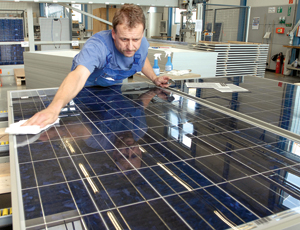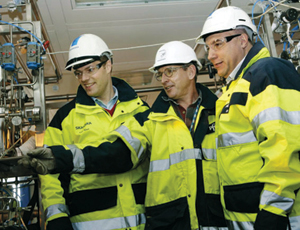Reaction to the broadening global economic crisis has hit much of the manufacturing and industrial process world hard and fast. Reduced consumer demand has led to swift production cuts at factories in many markets, while the credit crunch has prompted some companies to hoard cash. As manufacturers grapple with the issues of the day, future plans often take a back seat. Construction projects in many sectors have been cancelled or at best deferred, leaving many design and construction firms pessimistic about their backlogs.


When Mike Gearhart, president the manufacturing and life sciences group of Denver-based CH2M Hill Cos., touched down in Moscow on Sept. 15, he knew everything was about to change. “I popped on my Blackberry and saw that Lehman Brothers went into Chapter 11 and that Bank of America was buying Merrill Lynch. Things just went down from there,” he recalls. “Up until that point, we were far ahead of plan internationally. We’ll still finish the year ahead of plan, but the cancellations and all-stops are cutting into our backlog.”
For many U.S.-based companies like CH2M Hill, international business has been a growing part of their portfolios as they’ve followed western clients to jobsites around the globe. In Russia, CH2M Hill has banked recently on opportunities in basic commodities like food and beverages, but consumer demand coupled with political uncertainty within that country has cooled interest among many manufacturers.
“If you look at the [foreign direct investment] in Russia, it’s completely dried up and stopped,” Gearheart says.
Perhaps the most dramatic collapses have been in the auto sector, where both U.S.-based and non-U.S. manufacturers are reporting massive double-digit sales drops. As executives from The Big Three wait to see if Congress will float nearly $25 billion in loans to them, cutbacks are under way. Shortly after announcing a two-month plant shutdown in Rayong, Thailand, GM put plans to build a $445-million diesel engine plant in that province on hold.
Japan’s Toyota recently cut its production in Thailand after its sales in the county fell by 21%. Ford and Mazda are currently building a $500-million expansion at a facility in Rayong for production of compact cars, but no project stoppages have been announced.
The auto market remains clouded as consumers continue to hold off on purchases, and construction firms are adapting.
“Right now, the auto sector is not a complete unknown in the sense that we know we’ll see significant shake-up in the industry over the next 12 months,” says Greg Kozicz, president of St. Louis-based Alberici Constructors. “What’s more unknown is what happens 12 months from now.”
Before investing in new projects, Kozicz says he sees many automakers and their suppliers preserving cash while they wait to see which manufacturers survive. “The strongest will survive, and that should be good for the long-term stability of the sector,” he says.
But the effects may not be felt for years. Kozicz expects to see Alberici’s top-line growth drop by 10% in 2009 with softness continuing into the following year. “In 2010, we’ll start to hear about projects that will be available to us in 2011,” he adds.
For now the company hopes to continue with its current work. Alberici is construction manager on a $1-billion assembly plant for Volkswagen planned near Chattanooga, Tenn., expected to be completed in 2010.
Given the slim prospects, Kozicz says Alberici expects to move some of its personnel into other sectors, such as infrastructure, until the auto market returns.
Shifting staff could prove a common theme among design and construction firms in the coming months. Tim Gelbar, president of London-based AMEC’s Power and Process Americas unit in Atlanta, says in light of the soft process market, AMEC expects to move more of its resources to the power market in 2009.
Gelbar says the company hopes to build the case its among clients that have cash that the sagging construction market could actually work to their benefit.
“If you have a project that makes sense from a business perspective and you do have access to capital, it might be a good time to do a project,” he says. “Just look at pricing on equipment and materials. Clients could get reasonably aggressive pricing today. We’ve had a few clients ask for feedback on whether they should build. I wish there were more of those calls though.”
But improved prices of commodities underscore the struggle among the firms that bank on work from materials producers. Major producers in metals have announced significant cuts, including ArcelorMittal dropping global steel production by 30%. In November, Nippon Steel announced double-digit dips through March. Alcoa joined the trend in late 2008, slashing output by 15%.
Similar concerns can be seen in the chemicals market. In November, German chemical giant BASF announced it would temporary shut down 80 plants and cut production at another 100 plants worldwide.
Despite the drastic drop-off in potential construction, some firms are finding other opportunities. The Netherlands-based Arcadis is focusing more of its efforts on compliance and operations issues within the chemical industry. Many companies are hiring firms to help them comply with the European Union’s Registration, Evaluation, Authorization and Restriction of Chemical substances regulations [REACH], enacted in 2007, says Curt Cramer, executive vice president of environmental services at Arcadis. As a result, Cramer says his firm is pursuing more opportunities through its global product stewardship unit.
“It’s not discretionary spending,” he says. “If companies want to export to the EU, they have to do this.”
Even with cutbacks across most industries, many firms are hoping the green movement will continue its surge and drive construction projects. Solar-panel factories and the materials needed to produce them continue to hold some promise. Ir-ving, Texas-based Fluor Corp. is building a $1-billion polysilicon project in China for LDK Solar and expects to wrap up work in mid 2009.
In July, Fluor broke ground on a $420-million deal to build a new solar-panel plant in Singapore, which is scheduled to be completed in 2010.
Japanese firm Tokuyama Corp. awarded an engineering contract to Chiyoda Corp. of Japan in November to build a new polysilicon plant in Malaysia. The plant is expected to produce 3,000 tons of polysilicon when it opens in 2012.
Another ray of hope can be seen in the biotech and pharmaceutical markets. Although billion-dollar megaprojects, such as those rolled out in recent years by Thousand Oaks, Calif.-based Amgen, may be a thing of the past, companies are eyeing other opportunities.
Pasadena, Calif.-based Jacobs Engineering Group Inc. is providing engineering, procurement and construction management for an expansion of Genzyme’s biopharma fill/finish tableting plant in Waterford, Ireland. The project is scheduled to finish in 2009. Jacobs also is part of a team working with Ireland’s National Institute for Bioprocessing Research and Training to plan pilot-scale research laboratories and other educational facilities in Dublin.
In August, Perryville, N.J.,-based Foster Wheeler won a contract from Alcon Laboratories for a new 250,000-sq-ft manufacturing facility in Tuas Biomedical Park in Singapore.
Dean Poilluci, leader of Skanska’s Science and Technology Center of Excellence, says the firm’s U.S. operations unit is looking to partner with its European counterparts on potential jobs in Europe, as U.S.-based pharmaceutical companies consider opportunities across the Atlantic. Skanska teams from the U.S. and Sweden previously partnered on a $180-million biotech facility being built for Pfizer in Strangnas, Sweden. That project is scheduled to be completed in 2009.
“The opportunities we see are with the big U.S.-based companies that have an interest in European markets where we already have locations and can bring local knowledge,” Poilluci says.
Although investment in the pharmaceuticals sector has seen significant shifts in recent years, Poilluci doesn’t see the current global financial crisis having a significant impact. “If a pharma client has a product that’s ready to go and they need a facility, they won’t let the opportunity go by without retrofitting or building a new facility,” he says.
Ivor Harrington, senior vice president of manufacturing and life sciences at Fluor, agrees that many life-sciences companies are “pretty immune to the financial crisis” as demand for pharmaceuticals moves ahead regardless of the financial markets. Although the major clients of the past may be off the radar screen for now, others are emerging.
“We’ve seen some [companies] surface in just the past few months with projects that could happen in early 2009,” he says. “We’re not talking about anything like Amgen’s billions, but projects in the $300-million to $500-million range. That’s a lot less than we were seeing two years ago, but much better than six months ago.”

Post a comment to this article
Report Abusive Comment